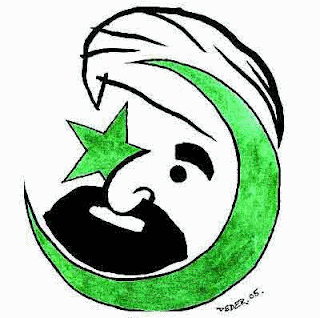 டென்மார்க் பத்திரிகையில் முகமது நபியின் காட்டூன்கள் வெளியானதும், அதைத் தொடர்ந்து அந்த பத்திரிகை நிறுவனத்திற்கு எதிராகவும், டென்மார்க் நாட்டிற்கும் மக்களுக்கும் எதிராகவும் உலககலாவிய ரீதியில் முஸ்லீம் உலகில் எழுந்த எதிர்ப்பும் நீங்கள் அறிந்திருப்பீர்கள். பின்னர் அது அந்த காட்டூனை வரைந்த ஒவியரின் தலைக்கு முஸ்லீம் மதத்தலைவர்களால் விலைகுறிக்கப்பட்டு, இன்று அந்த விலைக்காக தலையை கொய்ய வந்தவர்கள் பிடிபட்டது வரை வந்திருக்கிறது.
டென்மார்க் பத்திரிகையில் முகமது நபியின் காட்டூன்கள் வெளியானதும், அதைத் தொடர்ந்து அந்த பத்திரிகை நிறுவனத்திற்கு எதிராகவும், டென்மார்க் நாட்டிற்கும் மக்களுக்கும் எதிராகவும் உலககலாவிய ரீதியில் முஸ்லீம் உலகில் எழுந்த எதிர்ப்பும் நீங்கள் அறிந்திருப்பீர்கள். பின்னர் அது அந்த காட்டூனை வரைந்த ஒவியரின் தலைக்கு முஸ்லீம் மதத்தலைவர்களால் விலைகுறிக்கப்பட்டு, இன்று அந்த விலைக்காக தலையை கொய்ய வந்தவர்கள் பிடிபட்டது வரை வந்திருக்கிறது.
இப்படி பெரும் பரபரப்பை ஏற்படுத்திய அந்த காட்டூன்களையும் ஒரு தடவை பார்க்க வேண்டும் என்ற ஆர்வத்தில் தேடியதில் கிடைத்தவையே இவை. அதில் அப்படி நான் எதிர்பார்த்தளவில் பாரதூமாக எதுவும் எனது சிற்றறிவுக்கு தென்படவில்லை! பல மரணங்களையும், மரண தண்டனை அறிவிப்புகளையும் ஏற்படுத்தும் அளவுக்கு உங்களுக்கு எதாவது தென்படுகின்றதா?
இதுவே எனக்கு பிறப்பினால் திணிக்கப்பட்ட இந்து மதக்கடவுளர்களான சிவனையோ அல்லது இராமனையோ இப்படி ஒருவர் வரைந்தால் நான் ஏன் கோபப்பட வேண்டும்? வரைந்தவரின் தலையெடுக்கும் அளவிற்கு எனக்கு ஏன் மதம் பிடிக்கவேண்டும்?
அன்பை போதிப்பதாக கூறிக்கொண்டு புறப்பட்ட அனைத்து மதங்களும் தோல்வியடைந்து, இன்று மானிடவர்க்கத்தின் எதிரியாக உருவெடுத்துள்ளனவா? Muhammad standing on a cloud, greeting dead suicide bombers with "Stop Stop vi er løbet tør for Jomfruer!" ("Stop, stop, we have run out of virgins!"), an allusion to the promised reward to martyrs. Not sure how offensive this is to Muslims but Westerners are hard pressed to find this one offensive (and even consider it the funniest of the 12 cartoons).
Muhammad standing on a cloud, greeting dead suicide bombers with "Stop Stop vi er løbet tør for Jomfruer!" ("Stop, stop, we have run out of virgins!"), an allusion to the promised reward to martyrs. Not sure how offensive this is to Muslims but Westerners are hard pressed to find this one offensive (and even consider it the funniest of the 12 cartoons).
Journalist Kåre Bluitgen, wearing a turban with the proverbial orange dropping into it, with the inscription "Publicity stunt". In his hand is a child's stick drawing of Muhammad. The proverb "an orange in the turban" is a Danish expression meaning "a stroke of luck": here, the added publicity for the book.

Muhammad with a bomb in his turban, with a lit fuse and the Islamic creed written on the bomb. This drawing is considered the most controversial of the twelve by Muslims and invokes the most emotions in Westerners. Two angry Muslims charge forward with sabres and bombs, while Muhammad addresses them with: "Rolig, venner, når alt kommer til alt er det jo bare en tegning lavet af en vantro sønderjyde" (loosely, "Relax guys, it's just a drawing made by some infidel South Jutlander". South Jutland as reference would, for a Dane, connote the feeling of something like the middle of nowhere).
Two angry Muslims charge forward with sabres and bombs, while Muhammad addresses them with: "Rolig, venner, når alt kommer til alt er det jo bare en tegning lavet af en vantro sønderjyde" (loosely, "Relax guys, it's just a drawing made by some infidel South Jutlander". South Jutland as reference would, for a Dane, connote the feeling of something like the middle of nowhere). A police line-up of seven people wearing turbans, with the witness saying: "Hm... jeg kan ikke lige genkende ham" ("Hm... I can't really recognise him"). Not all people in the line-up are immediately identifiable. They are: (1) A generic Hippie, (2) politician Pia Kjærsgaard, (3) possibly Jesus, (4) possibly Buddha, (5) possibly Muhammad, (6) possibly Moses, and (7) journalist Kåre Bluitgen, carrying a sign saying: "Kåres PR, ring og få et tilbud" ("Kåre's public relations, call and get an offer").
A police line-up of seven people wearing turbans, with the witness saying: "Hm... jeg kan ikke lige genkende ham" ("Hm... I can't really recognise him"). Not all people in the line-up are immediately identifiable. They are: (1) A generic Hippie, (2) politician Pia Kjærsgaard, (3) possibly Jesus, (4) possibly Buddha, (5) possibly Muhammad, (6) possibly Moses, and (7) journalist Kåre Bluitgen, carrying a sign saying: "Kåres PR, ring og få et tilbud" ("Kåre's public relations, call and get an offer"). A nervous caricaturist, shakily drawing Muhammad while looking over his shoulder.
A nervous caricaturist, shakily drawing Muhammad while looking over his shoulder.

Drawing shows Muhammad prepared for battle, with a short sabre in one hand and a black bar censoring his eyes. He is flanked by two women in niqaabs, having only their wide open eyes visible. The Islamic star and crescent partially symbolizing the face of Muhammad; his right eye is the star, the crescent surrounds his beard and face.
The Islamic star and crescent partially symbolizing the face of Muhammad; his right eye is the star, the crescent surrounds his beard and face.


Muhammad standing in a gentle pose with a halo in the shape of a crescent moon. The middle part of the crescent is obscured, revealing only the edges which resemble horns.
இந்தக் காட்டூன்களையும் அதுபற்றிய விமர்சனங்களையும் யாழ் இணையத்தில் போடுவது மிகவும் பாரதூரமான விடயமாகும்.
இஸ்லாமியர் எங்கள் சகோதரர்கள் மன்னிக்கவும்
Saturday, 16 February 2008
டென்மார்க் பத்திரிகையில் முகமது நபியின் காட்டூன்கள
Subscribe to:
Post Comments (Atom)



1 comment:
தங்கள் பதிவு கண்டேன். இஸ்லாம் உருவ வழிபாட்டை வன்மையாக கண்டிக்கிறது. இறைவனை நேரில் கண்டவா யாருமில்லை. அப்படியிருக்க இறைவனை எப்படி உருவமாக வரைய முடியும்? சரி இதற்கும் நபிகள் நாயக உருவப்படத்திற்கும் என்ன தொடர்பு என தாங்கள் கேட்கலாம். இறைக் கொள்கையைப் போதித்த பல நல்ல மனிதர்கள் காலப் போக்கில் அவர்களே கடவுளாகக் கருதப்பட்டு பிற்காலத்தில் பாமர மக்கள்ட வணங்கத் தொடங்கிவிட்டனர். அன்பே கடவுள் என்று போதித்த புத்தரும், கடவுளின் தூதராக வந்த ஏசுமகானும் பிற்காலத்தில் கடவுளாகவே ஆக்கபட்டுவிட்டனா அல்லவா எனவே தான் தனது உருவத்தைக் கூட வரையக் கூடாது என் நபிகள் நாயகம் அவர்கள் தடைசெய்து இஸ்லாத்தில் உருவ வழிபாடு எந்த வகையிலும் ஊடுருவி விடக் கூடாது என்பதில் மிகவும் எச்சரிக்கையாக இருந்தார்கள்.
அதனால் நபிகள் நாயகம் அவர்களின் உருவப் படத்தை வரைவதை எந்த முஸ்லிமும் ஏற்கமாட்டார். முஸ்லிம்கள் தங்கள் உயிரினும் மேலாக மதிக்கும் தங்கள் தலைவரை உருவமாக வரைவதை எதிர்்க்கிறார்கள் எனும் போது அதை விட்டு தவிர்ந்துக் கொள்வது தானே நாகரிகம்.
Post a Comment